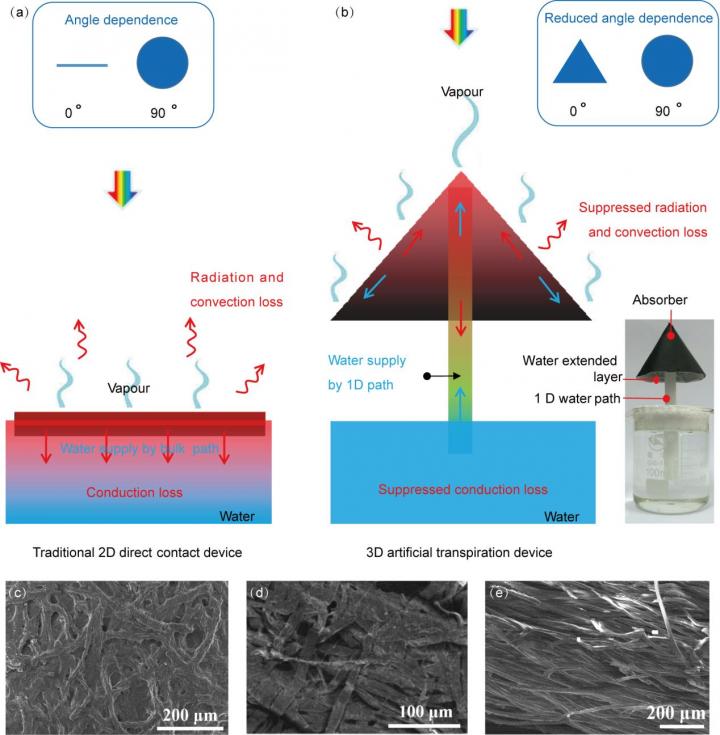Author:
Science China Press
Date
06/01/2017
Recently, solar steam and vapor generation is attracting a lot of attention with promising prospect in desalination, sterilization and chemical purification. Tremendous progress has been achieved as absorber designs (PNAS, 110, 11677-11681 (2013), Nature Comm. 6, 10103, (2015), Nature Photonics, 10, 393-398, (2016)) and thermal management (Nature Comm. 5, 4449, (2014), Nature Energy 1, 16133 (2016), PNAS, 113, 13953, (2016)). However, in all the previous designs, because of the minimized optical loss and heat conduction loss, losses related to convection and conduction start to dominant. Therefore, it becomes critical to simultaneous minimize the losses related to radiation, convection and conduction simultaneously in order to achieve optimum solar steam performance and enable widespread applications.

Click image to enlarge
(a) This is a schematics of traditional two dimensional solar steam generation with direct water contact. (Here, the conduction loss means the heat from the absorber to bulk water. The convection and radiation loss mean the heat from absorber to environment) (b) Schematics of three dimensional artificial transpiration device with suppressed heat loss. (The red straight arrows represent the direction of heat conduction. The red crooked arrows represent the direction of heat convection and radiation. The blue straight arrows represent the direction of water supply.)
In research reported in the National Science Review (NSR), Zhu group at Nanjing University, China has provided a new concept "artificial transpiration" with a graphene oxide based 3D hollow cone structure (Fig. 1). In this unique 3D artificial transpiration device, 1D water path was used to obtain efficient water supply and suppressed conduction loss at the same time. The radiation and convection losses were also minimized by lowering absorber temperature due to its increased evaporation surface area and carefully designed morphology. As a result, this device enable over 85% solar vapor efficiency under one sun irradiation without external thermal insulation and optical supporting systems.
Another feature in this 3D artificial transpiration device is the ability to collect more sunlight throughout the day, compared with a 2D flat horizontal device. In contrast to the fixed, simulated sun light used in the lab, the sun is constantly changing its position in the sky. Furthermore, large portion of the sunlight (10-50%) is diffusive, arriving to the receiver from all directions. The results show that 3D absorption structure can absorb more light (about ~24%) than 2D devices which is beneficial to real world applications.
It is also demonstrated that the artificial transpiration device can enable effective water treatment through two pathways, producing clean water condensed from vapor and recycling heavy metals. The extracted water from the condensed vapor is pure enough to meet WHO drinking water standards, even starting with waste water containing high concentrations of Cu2+, Cd2+, Pb2+ and Zn2+ (5000 mg/L, 5000 times higher than WHO drinking water standards). Meanwhile, the heavy metals as Au, Cu can be recovered.
Therefore, this artificial transpiration device provide a complementary approach for efficient, effective and portable solar water treatment.
EurekAlert!, the online, global news service operated by AAAS, the science society: https://www.eurekalert.org/pub_releases/2017-06/scp-atf060117.php